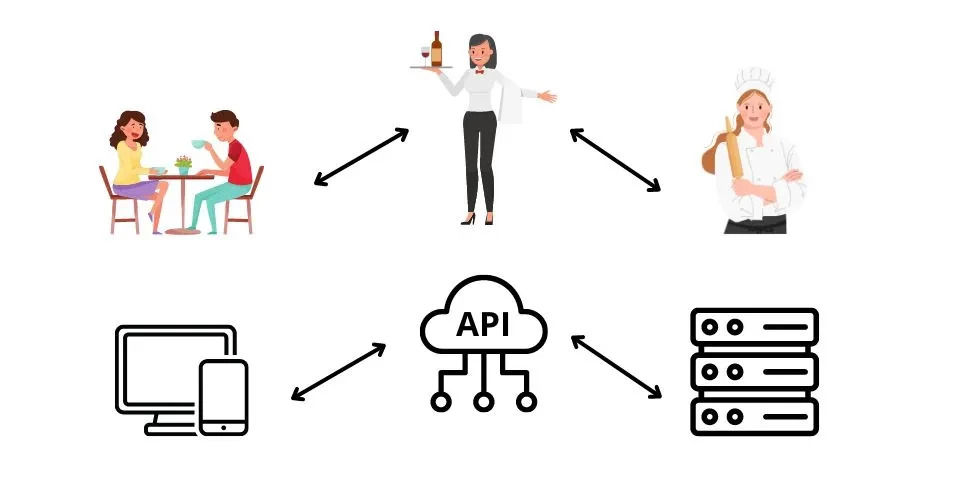Application Programming Interfaces, commonly known as APIs, form the foundation of the digital world we are immersed in.
Although it may seem like a technical concept, APIs play a fundamental role in our daily internet experience.
But what exactly do APIs represent?
How do they operate, and what importance do they hold in the context of an increasingly interconnected world?
Through this article, we will explore the definition of APIs, how they work, and their role in integration with a wide range of digital services.
From web browsing to using applications on our mobile devices, APIs are the invisible yet essential element that ensures the smooth operation of everything digital around us.
What Are APIs
APIs are a set of rules and protocols that facilitate communication between different applications and computer systems.
They act as intermediaries, enabling the exchange of data and functionality between heterogeneous software.
In other words, APIs can be considered the "language" through which applications communicate with each other.
Thanks to them, it is possible to integrate different features, services, and data from a wide range of sources.
This integration process allows for richer and more interconnected digital experiences, enabling applications to collaborate and provide users with a more complete and personalized experience.
What Are APIs Used For
APIs play a fundamental role, acting as an invisible bridge between different applications and online services.
Their usefulness is extremely versatile and extends to many areas.
For example, APIs allow websites to integrate and display up-to-date information from external sources, such as stock availability or real-time financial data.
This means a website can offer its visitors always updated and relevant content without having to create and maintain that data internally.
Furthermore, APIs enable interaction between different applications on mobile devices.
This allows apps to leverage third-party functionalities, such as access to social media or content sharing, thus enriching the user experience and expanding the capabilities of the applications themselves.
APIs play a vital role in the e-commerce sector, enabling online stores to access and integrate a range of essential external services.
These services, ranging from payment systems to shipment tracking and inventory management, form the pillars on which a modern and efficient online store operates.
First of all, payment systems are crucial for allowing buyers to perform transactions securely and conveniently.
Through APIs, online stores can integrate a wide range of payment methods, such as credit cards, PayPal, bank transfers, and digital wallets.
This diversification of payment methods helps satisfy buyers' preferences and improves sales conversion.
Inventory management is another key area made possible thanks to APIs.
Online stores need to keep track of their stock in real-time, managing updates on available quantities, adding new products, and removing out-of-stock items.
Through APIs, stores can integrate existing or third-party inventory management systems, automating and simplifying this crucial process.
Finally, shipment tracking is essential for providing a good post-purchase experience to customers.
Thanks to APIs, online stores can connect to shipping and delivery tracking services, allowing buyers to monitor the status of their shipments in real-time.
This transparency and visibility improve customer trust and reduce the risk of delivery-related issues.
APIs: What Are the Advantages
The use of APIs offers a series of extraordinary advantages that go far beyond the mere scope of software development.
The high efficiency in integration between different systems and applications is one of the main advantages offered by APIs.
This aspect becomes crucial in an increasingly complex and interconnected digital landscape, where organizations must be able to enable communication among a wide range of software solutions.
APIs act as virtual bridges, allowing smooth and direct communication between heterogeneous systems.
Thanks to them, it is possible to overcome language and protocol barriers that would otherwise make interoperability between different platforms and applications difficult.
This means an application can access and use data and functionalities of another application without having to reprogram everything from scratch.
This integration process facilitates the exchange of data and information in real time, ensuring that information is always updated and accessible wherever necessary.
For example, a human resources management application can seamlessly access employee information stored in an accounting system, allowing administrators to have a comprehensive and updated view of staff at any time.
The ease of integration offered by APIs encourages the creation of interconnected digital ecosystems, where different applications and services can collaborate seamlessly.
This is especially advantageous in sectors like e-commerce, healthcare, and transportation, where a wide range of services must work together to provide a complete and integrated user experience.
Not less important, APIs play a fundamental role in digital innovation, providing developers with a solid infrastructure on which to build new applications, services, and even entire industries.
This happens through various mechanisms that foster creativity and technological evolution.
First, APIs offer developers access to a vast ecosystem of existing functionalities and data.
This means that instead of reinventing the wheel each time, developers can focus on creatively using these preexisting resources to create innovative and unique solutions.
For example, a mapping application can integrate the APIs of a geolocation service to offer advanced navigation features without having to develop the entire geolocation system from scratch.
Moreover, APIs encourage modularity and code reusability.
Developers can create and distribute autonomous software components, known as microservices, which expose their functionalities through well-defined APIs.
This allows developers to combine and assemble these components in new and innovative ways, accelerating development and enabling faster evolution of applications.
APIs can also serve as catalysts for collaborative innovation.
Companies can publish open APIs that allow third parties to develop and integrate new features into their products and services.
This creates a shared development ecosystem where ideas can flow freely and innovation can emerge from diverse and unexpected sources.
How APIs Work and How They Integrate
APIs act as digital channels that allow different software and applications to communicate with each other in an understandable language.
They operate through a series of requests and responses, offering a smooth and flexible structure for the exchange of data and functionalities.
One way to imagine how APIs work is to compare them to a restaurant menu: the customer (the application or software) consults the menu (the API) and places an order (a request).
The restaurant (the API) processes the order, prepares the meal (executes the requested operations), then serves the dish (returns a response). This response can be a set of data, information, or functionalities that the original application can then use to its advantage.

APIs operate on well-defined communication principles, often based on standard web protocols such as HTTP or HTTPS.
These protocols establish the rules for data transfer between the application making the request and the API itself.
The documentation associated with each API plays a crucial role in the entire integration and usage process.
This document provides detailed guidance on how to interact with the API, including how to formulate requests and what to expect in responses.
First, the documentation specifies how requests must be formulated.
This includes information on which API endpoint to use, which parameters to include in the request, and how to structure the data payload if necessary.
This information is essential for developers as it ensures that the requests sent to the API are correct and that they can obtain the desired responses.
Moreover, the documentation clarifies what responses to expect from the API.
This includes information on the format of the returned data, the HTTP status codes indicating the outcome of the request, and any errors or exceptions that might occur during interaction with the API.
Understanding possible API responses is crucial for properly handling responses and providing an appropriate reply to the end user.
This principle of structured communication underpins most of the digital services we use daily, from gathering weather data on your smartphone to online banking transactions.
APIs are the secret gear that holds our digital world together, enabling developers to create more complex, interconnected, and powerful applications.
In Brief...
This article allowed us to explore the vital role that APIs play in the contemporary digital landscape.
These tools are the lifeblood that enable a variety of applications and systems to communicate smoothly, acting as a universal "language" that facilitates collaboration between heterogeneous software.
Using APIs offers significant advantages, including improved efficiency, greater flexibility, innovation, and a more satisfying user experience.
There are different categories of APIs, each designed for a specific purpose in programming and software interaction.
These tools operate through a request-and-response exchange process based on standard web protocols, allowing efficient and reliable interaction between applications.
API integration is a crucial step to fully harness their potential.
This process allows existing applications to enrich their capabilities by incorporating services and data from a wide range of external sources.
Thanks to this, applications can offer users a richer and more complete experience while maintaining a high level of flexibility and adaptability.



